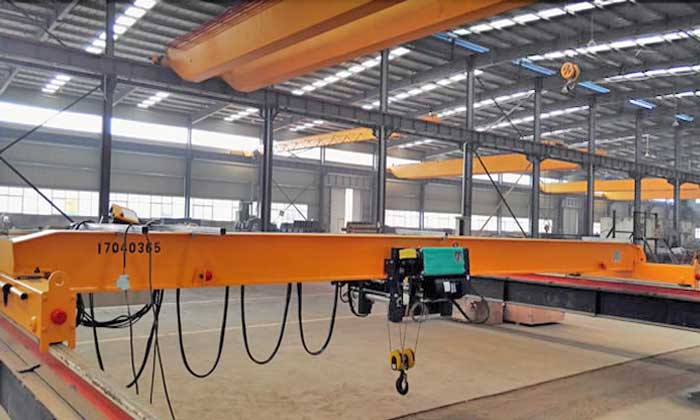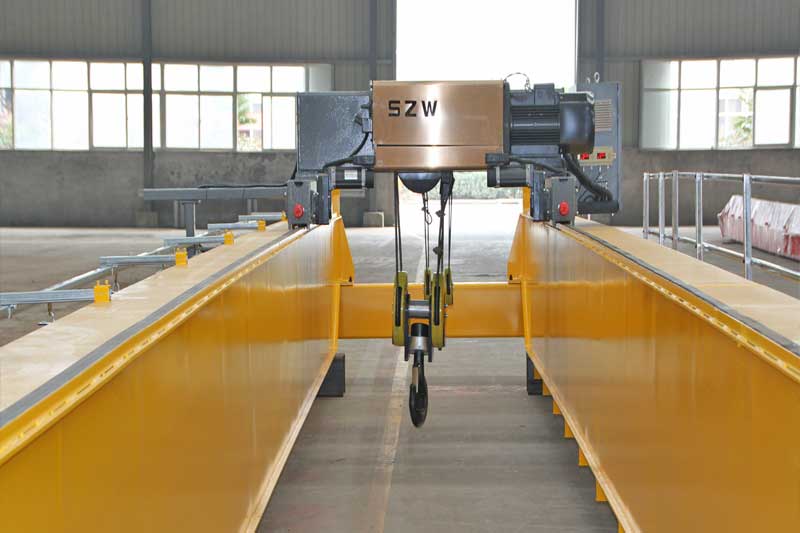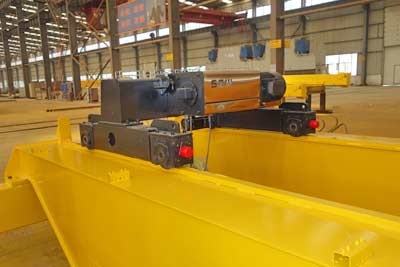Overhead Cranes for LargeScale Mold Handling 5 Ton, 10 Ton, 20 Ton
In the realm of precast concrete manufacturing, where precision and efficiency are paramount, the role of advanced machinery cannot be overstated. In the pursuit of constructing resilient and meticulously crafted structures, the handling of largescale molds is a pivotal aspect of the production process. This blog delves into the significance of efficiency in precast concrete manufacturing, shining a spotlight on the indispensable role played by overhead cranes in the handling of substantial molds.
Efficiency is the linchpin of success in the precast concrete industry. With demands for highquality, customized structures on the rise, manufacturers are continually seeking ways to optimize their processes. In precast concrete manufacturing, where each mold represents a unique piece of the puzzle, streamlining operations is not just a goal; it's a necessity.
The need for efficiency extends beyond mere productivity; it encompasses the precision required to ensure the accuracy and integrity of the final product. Whether it's the creation of precast concrete molds, handling formwork panels, or positioning large structural components, every step in the manufacturing journey demands a harmonious blend of speed and accuracy.
One of the key catalysts for achieving efficiency in precast concrete manufacturing is the utilization of overhead cranes. These sophisticated lifting solutions have revolutionized the way molds are handled, offering a seamless blend of power, precision, and safety.
Overhead Cranes for Mold Handling
Overhead cranes, often referred to as bridge cranes or suspended cranes, are sophisticated materialhandling machines designed for heavy lifting within industrial settings. Their defining feature is the overhead bridge that spans the workspace, supported by parallel runways. Attached to this bridge is a movable hoist, which can travel horizontally along the length of the bridge, providing a wide range of coverage.
Types of Overhead Crane for Mold Handling
Key Characteristics of Overhead Cranes:
- Bridge Structure: The overhead crane's bridge, comprising beams and a trolley, spans the workspace.
- Runways: Parallel runways support the bridge structure, ensuring stability and precision during movement.
- Hoist: The hoist, equipped with hooks or other lifting attachments, is suspended from the bridge and can move both horizontally and vertically.
- Versatility: Overhead cranes are adaptable to various configurations, including single girder or double girder designs, making them suitable for diverse applications.
Why Overhead Cranes are Suitable for Precast Concrete Manufacturing:
- Precision Handling of Heavy Loads: The primary advantage of overhead cranes in precast concrete manufacturing lies in their ability to handle heavy and cumbersome loads with exceptional precision. The robust bridge structure and advanced hoisting mechanisms ensure that molds, formwork panels, and large structural components can be lifted and maneuvered with accuracy.
- High Load Capacities: Overhead cranes boast high load capacities, making them wellsuited for the substantial molds used in precast concrete manufacturing. This capability enables manufacturers to handle oversized and weighty components efficiently, contributing to increased productivity.
- Customization for Unique Requirements: The versatility of overhead cranes allows for customization based on the specific needs of precast concrete manufacturing plants. Whether it's adapting to varying mold sizes or accommodating complex lifting requirements, overhead cranes offer tailored solutions.
- Efficient Space Utilization: With their elevated structure, overhead cranes optimize floor space utilization in manufacturing facilities. The ability to move heavy loads horizontally reduces the need for extensive floorbased infrastructure, providing a clear advantage in congested or spacelimited environments.
- Safety in Operation: Overhead cranes are equipped with advanced safety features, including precision controls, limit switches, and emergency braking systems. These features ensure not only the safety of the manufacturing process but also the wellbeing of the personnel working in the vicinity.
In the dynamic landscape of precast concrete manufacturing, where efficiency and precision are paramount, overhead cranes stand out as indispensable tools, seamlessly integrating into the production process and contributing to the creation of highquality, durable structures.
Typical Loads Handled
Precast Concrete Molds
Precast concrete molds, the foundational elements in the manufacturing process, come in various sizes and weights. These molds serve as the templates for shaping concrete into specific forms, contributing to the creation of diverse precast concrete components. The sizes can range from relatively small molds for intricate details to significantly larger molds for sizeable structural elements.
- Sizes: Precast concrete molds can vary from compact forms, such as those for ornamental detailing, to extensive molds for panels or architectural elements.
- Weights: The weight of precast concrete molds depends on their dimensions and the intended use. Smaller molds may be manageable manually, while larger molds necessitate specialized lifting equipment.
Handling large precast concrete molds demands specialized equipment capable of managing substantial weight and ensuring precise positioning. Overhead cranes play a pivotal role in this regard, offering the following advantages:
- Precision Handling: Overhead cranes provide the accuracy required to position large molds with utmost precision, contributing to the overall quality of the precast concrete components.
- Weight Capacity: The robust design and high load capacity of overhead cranes make them wellsuited for lifting and transporting large molds efficiently, reducing the risk of damage or deformities.
- Versatility: Overhead cranes can be customized to accommodate different mold sizes and shapes, offering versatility in handling various precast concrete elements.
Formwork Panels
Formwork panels are critical components in precast concrete production, serving as the molds into which concrete is poured to create specific shapes and structures. These panels are responsible for imparting the desired finish and details to the concrete elements, making them integral to the overall aesthetic and functional characteristics of the final product.
- Architectural Detailing: Formwork panels enable the reproduction of intricate architectural details, contributing to the visual appeal of precast concrete components.
- Consistent Finish: The use of formwork panels ensures a consistent finish on the concrete surface, meeting quality standards and architectural specifications.
While formwork panels are essential, their handling poses challenges that need to be addressed efficiently. Overhead cranes emerge as the ideal solution for overcoming these challenges:
- Delicate Handling: Overhead cranes, equipped with precision controls, allow for delicate handling of formwork panels, minimizing the risk of surface damage.
- Quick Positioning: The ability to swiftly position formwork panels is crucial for maintaining a streamlined production process. Overhead cranes facilitate rapid and accurate placement.
Large Structural Components
Precast concrete manufacturing involves the production of a diverse range of structural components, each designed for specific applications. These components encompass columns, beams, panels, and other elements that form the building blocks of architectural and infrastructural projects.
- Columns and Beams: Structural columns and beams are fundamental elements in precast concrete construction, providing support and stability to structures.
- Panels: Large precast concrete panels are commonly used for building facades, walls, and flooring, requiring specialized handling due to their size and weight.
Efficient handling of large and heavy structural components is crucial for maintaining a smooth workflow in precast concrete manufacturing. Overhead cranes excel in this aspect, offering:
- Heavy Load Capacity: Overhead cranes are designed to handle substantial weights, making them wellsuited for lifting and moving large structural components.
- Reduced Downtime: The efficient handling capabilities of overhead cranes contribute to minimized downtime in the manufacturing process, enhancing overall productivity.
- Enhanced Safety: Overhead cranes are equipped with safety features that ensure the secure handling of heavy elements, safeguarding both workers and valuable components.
In the intricate world of precast concrete manufacturing, where precision meets production, the handling of typical loads such as molds, formwork panels, and large structural components is elevated to an art form. The synergy between these loads and advanced overhead crane technology exemplifies the commitment to excellence in the creation of durable, aesthetically pleasing, and structurally sound precast concrete elements.
Overhead Crane Operation for Lifting and Positioning Molds
Overhead cranes play a pivotal role in the intricate process of lifting and positioning precast concrete molds, ensuring a seamless and efficient workflow. The detailed steps involved in this application highlight the precision and capabilities of overhead cranes:
- Hoisting Mechanism: The hoisting mechanism of the overhead crane is engaged to attach lifting equipment securely to the precast concrete mold.
- Variable Speed Controls: Overhead cranes are equipped with variable speed controls, allowing operators to lift the mold with utmost precision, avoiding any sudden movements that could impact the mold or the surrounding infrastructure.
- Customized Attachments: The versatility of overhead cranes allows for the customization of lifting attachments based on the specific design and dimensions of the precast concrete mold.
- Smooth Vertical Movement: Overhead cranes facilitate a smooth and controlled vertical movement, minimizing the risk of oscillations or swaying during the lifting process.
Importance of Precise Positioning for Mold Accuracy in the Casting Process
The accuracy of precast concrete elements relies heavily on the precise positioning of molds during the casting phase. Overhead cranes contribute to this accuracy in the following ways:
- Targeted Placement: Overhead cranes allow for targeted placement of precast concrete molds, ensuring that they align perfectly with the intended casting area.
- Adjustable Heights: The vertical adjustability of overhead cranes ensures that molds can be positioned at varying heights, accommodating the requirements of diverse precast concrete components.
- Angular Adjustments: Overhead cranes offer the flexibility for angular adjustments, enabling the precise orientation of molds for optimal casting results.
- Minimized Handling Errors: The use of overhead cranes minimizes the likelihood of handling errors, ensuring that molds are positioned accurately for a flawless casting process.
Overhead Cranes in the Overall Precast Concrete Manufacturing Process
Beyond the specific task of lifting molds, overhead cranes play a pivotal role in the broader context of the precast concrete manufacturing process. Their applications extend to various stages, contributing to the overall efficiency of the operation:
- Material Handling: Overhead cranes are instrumental in transporting raw materials, such as reinforcing steel and aggregates, to designated areas within the manufacturing facility.
- Transportation of Components: Once precast concrete elements are cast, overhead cranes are utilized to transport the components to curing areas or storage locations.
- Assembly Assistance: In cases where precast elements require assembly, overhead cranes provide invaluable assistance in lifting and positioning components for seamless integration.
Ensuring Safety and Efficiency During the Casting Phase
Safety and efficiency are paramount during the casting phase of precast concrete manufacturing, and overhead cranes contribute significantly to achieving these goals:
- Reduced Manual Handling: Overhead cranes minimize the need for manual handling, reducing the risk of injuries associated with lifting heavy components.
- Quick Turnaround: The efficient handling capabilities of overhead cranes contribute to a quick turnaround in the casting phase, enhancing overall production efficiency.
- Safety Features: Overhead cranes are equipped with safety features such as overload protection, emergency braking systems, and antisway technology, ensuring a secure casting environment.
- Operator Control: Operators have precise control over the movement of the crane, allowing them to navigate through the casting process with accuracy and confidence.
In essence, overhead cranes are the unsung heroes in the precast concrete manufacturing realm, elevating the efficiency, precision, and safety of lifting and casting processes. From the initial hoisting of molds to the final assembly of precast elements, the application of overhead cranes ensures a harmonious and streamlined manufacturing journey.
Benefits of Overhead Cranes in Precast Concrete Manufacturing
Streamlining the Mold Handling Process for Enhanced Productivity
The incorporation of overhead cranes in precast concrete manufacturing brings forth a myriad of efficiencydriven benefits, particularly in the mold handling process:
- Swift Vertical and Horizontal Movements: Overhead cranes facilitate rapid vertical and horizontal movements, significantly reducing the time required to transport molds between different workstations.
- Optimized Workflow: The seamless integration of overhead cranes streamlines the overall workflow, eliminating bottlenecks and ensuring a continuous and efficient production process.
- Multiple Load Handling: Overhead cranes can handle multiple molds simultaneously, allowing for batch processing and further contributing to enhanced efficiency.
Reducing Downtime Through Efficient Crane Operations
Downtime in precast concrete manufacturing can be a significant hurdle to productivity. Overhead cranes play a crucial role in minimizing downtime through:
- Quick Changeovers: Overhead cranes facilitate swift mold changeovers, allowing for rapid transitions between different production runs without prolonged interruptions.
- Reliable Performance: The robust design and advanced technology of overhead cranes contribute to their reliability, reducing the likelihood of breakdowns and unplanned downtime.
- Efficient Maintenance Practices: Overhead cranes are designed for ease of maintenance, enabling timely inspections and preventive measures to further decrease the risk of unexpected downtime.
Ensuring Accurate Positioning for HighQuality Precast Concrete Elements
Precision is a cornerstone of highquality precast concrete manufacturing, and overhead cranes play a pivotal role in achieving accurate positioning of molds and components:
- Exact Placement: Overhead cranes provide operators with precise control, ensuring that molds are positioned with accuracy, resulting in consistently highquality precast concrete elements.
- Minimized Defects: Accurate positioning minimizes the risk of defects in the finished products, contributing to the overall quality and marketability of precast concrete components.
Importance of Safety Features in Overhead Cranes for the Protection of Workers and Equipment
Safety is paramount in any manufacturing environment, and overhead cranes are equipped with advanced features to safeguard both workers and equipment:
- Overload Protection: Overhead cranes are designed with overload protection systems, preventing the crane from lifting loads beyond its rated capacity, thus ensuring structural integrity and operator safety.
- Emergency Braking Systems: The inclusion of emergency braking systems enhances safety by allowing for immediate halting of crane movements in case of unforeseen circumstances.
- AntiSway Technology: Overhead cranes are often equipped with antisway technology, minimizing swinging motions during load handling and reducing the risk of collisions or accidents.
- Operator Training and Certification: Ensuring that crane operators are welltrained and certified further contributes to a safe working environment, preventing accidents and injuries.
In conclusion, the benefits of overhead cranes in precast concrete manufacturing extend far beyond mere material handling. The increased efficiency, precision, and safety they bring to the mold handling process are integral components of a successful and sustainable manufacturing operation.
Wrap it Up, Get Your Custom Precast Concrete Mold Handling Overhead Crane
As the precast concrete manufacturing sector continues to evolve, the role of overhead cranes will remain pivotal. The fusion of precision, safety, and technological innovation embodied by overhead cranes symbolizes the industry's commitment to excellence and its journey towards a more efficient, sustainable, and technologically advanced future.
Efficiency and Productivity: Overhead cranes streamline the mold handling process, enhancing overall efficiency and productivity in precast concrete manufacturing plants. Their ability to swiftly and accurately transport molds contributes to optimized workflows and reduced downtime.
- Versatility in Load Handling: The versatility of overhead cranes allows for the handling of a diverse range of precast concrete molds, formwork panels, and large structural components. This adaptability ensures that manufacturers can cater to a variety of architectural and construction requirements.
- Precision in Positioning: The precise control offered by overhead cranes during the lifting and positioning of molds ensures accuracy in the casting process. This precision is crucial for achieving highquality precast concrete elements with consistent finishes and minimal defects.
- Safety Assurance: Equipped with advanced safety features, overhead cranes contribute to a safer working environment. From overload protection to emergency braking systems, these safety measures safeguard both workers and valuable equipment, reducing the risk of accidents.
- EnergyEfficient Solutions: The integration of energyefficient features in overhead cranes aligns with industrywide efforts to reduce environmental impact. Energyefficient operations not only lower operational costs but also position precast concrete manufacturing plants as environmentally responsible entities.
- Customization for Diverse Needs: Overhead cranes are not onesizefitsall solutions. The ability to customize crane configurations and attachments based on specific manufacturing needs ensures flexibility and adaptability, crucial in an industry characterized by diverse project requirements.
If you have any need of mold handling overhead cranes for your precast concrete manufacturing business, please feel free to contact us to get your custom design . Contact us today to check what we can do to save your cost.








